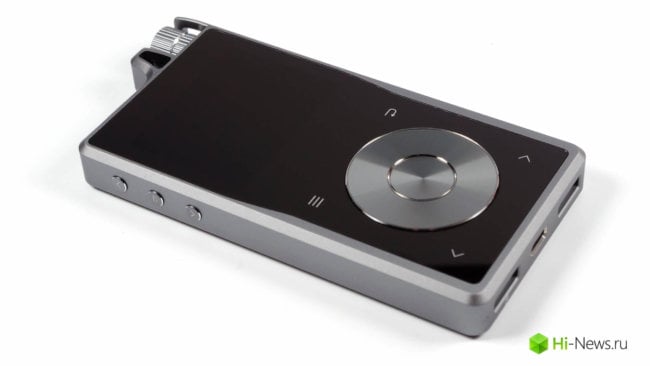
The company Questyle took his player QP1R a very interesting niche. He was never among the leaders in the “comments” on the forums, but have enjoyed stable demand among connoisseurs of sound. Interesting design, brand amp and fairly easy management made the model popular among the audiophiles, but for a long time to keep market share with one model will not work, so Questyle has released a new model QP2R.
The company clearly point out the recent trends, so the main update is related to the amplifier, he is now fully balanced, and the player provides the corresponding output. Took into account the shortcomings of usability, QP2R got separate buttons for navigating through tracks. In General, however, the case remains the same, the developers decided that the design received the iF Design Award, it just should not be changed.
Of small pluses there are still a few changes in the ergonomics, which I will discuss below, and the older memory of the player. Of the minuses — removed one slot for MicroSD-cards and the older price, who wants to buy QP2R now we have to part with a sum that is roughly equivalent to 1300-1400 dollars.
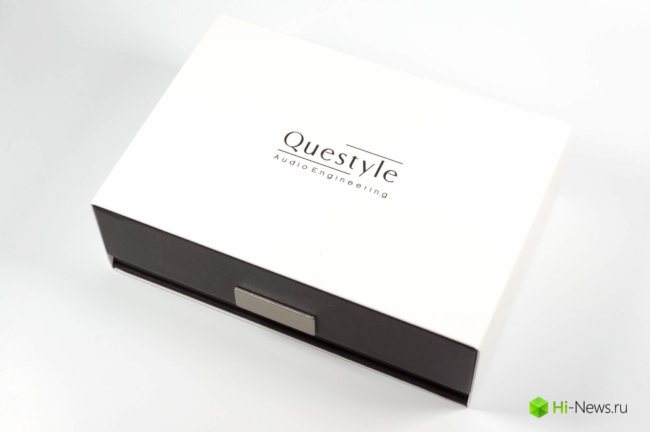
Specifications
- DAC: AKM AK4490
- Output impedance: 0,1 Ω
- Frequency range: 20 Hz – 20 kHz (±0,1 dB)
- The ratio signal/noise: 100 dB at normal output, 102 dB balanced
- Total harmonic distortion+noise: about 0.0006% at normal output, of 0.0005% on balance
- Output level: 1,6 Vrms on a normal output, a 3.2 Vrms on balanced
- Normal power output: 38 mW @ 32Ω, 9 mW @ 300Ω
- Power balanced output: 70 mW @ 32Ω, 38 mW @ 300Ω
- Formats supported: WAV, FLAC, WMA, MP3, OGG, AAC, ALAC, AIFF, DFF, DSF, APE
- Maximum resolution: 384kHz/32bit, DSD up to DSD256
- Input: USB Type C
- Outputs: 3.5 mm nauchnikov, 2.5 mm balanced
- Built-in memory: 64 GB
- External memory: MicroSD
- Battery: Li-Polymer, 3100 mAh, 3.7 V
- Working time on single charge: ~10 hours
- Screen: IPS 2,4″
- Dimensions: 65 mm × 134 mm × 14.5 mm
- Weight: ~ 214 g
Packing and delivery
QP2R box made a little smaller than many of its competitors, but this did not prevent the designers to give it the maximum “feeling premium”. External dust cover white color hides the pack of black cardboard, drop into two equal compartments. In the right part lies with the player to the left accessories: adapter for S/PDIF output, fabric little pouch for storage of player and USB-C-wire. Also included are various instructions/garantiyku.
Disappointing lack of complete cover, so for the player, against the producers of the lower segments of the investing cases even to the players for 150-200 dollars, this “thriftiness” Questyle looks doubtful.
By the way, the company developed a beautiful dock with a remote control, is designed for those wishing to use a player with fixed appliances, it is very stylish and comfortable, but it also needs to be purchased separately.
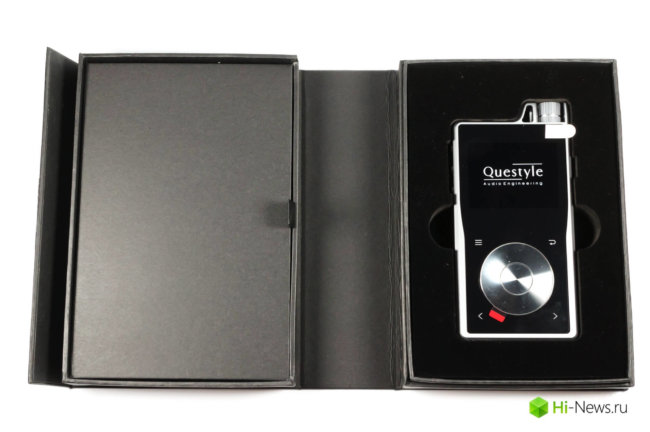
Design and management
As I wrote above, change the appearance of QP2R minimal. The size and shape of the body remained the same, too. In Questyle obviously inspired by the classic Apple in the face of the iPhone 4 and made a aluminium case with glass in the role of the front and rear panels. The player is available in gray and Golden colors, both look very nice. Naturally, glass panels how spectacular, is just as impractical. They collect fingerprints (easily scour due to the oleophobic coating) and are not durable, so the player is able to give some unforgettable, full of adrenaline moments during the flight on the tarmac due to retract past the pocket. In General, I recommend the book player along with a case. But on the other hand, like to hide in cover such beauty? Yeah, the dilemma…
The controls are spread on all surfaces of the player. On the left side I added three buttons for navigating through tracks and playback start/pause. They really improve the ergonomics of the player in the field of management “blindly”. The buttons are made of very high quality, with a pleasant click.
The top face has two slots: 3.5 mm and 2.5 mm, both serve to connect the headphones, but more can still provide a digital signal via the supplied adapter. There is also the volume control knob is protected from accidental turn-by-turn protrusions of the housing. Adjusting the volume there are digital, use a good encoder, so the regulator rotates with a clear and well fixed with a few clicks.
On the right side hosts the power switch, it traditionally turns off the screen and blocks buttons, next to it is the indicator with the color of the selected BIAS.
On the bottom are the USB connector (supports USB-DAC) and slot for memory cards. Unfortunately, in the new model it is only one, apparently, is a compromise that had to go because of the complexity of the amplifier circuit (it is necessary to place in the body).
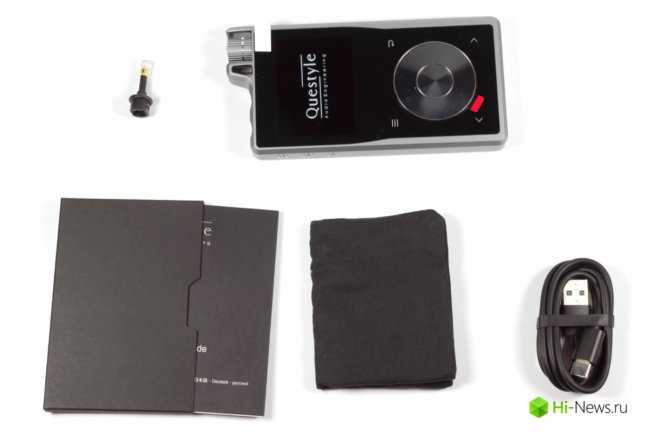
The front panels are quite expected, it has a screen, it is not the bright sun it is hard to read, but good resolution and bright colors in other situations, allows him to look “level”. Under the screen is placed a steering wheel and 4 touch buttons: navigation, return back to the submenu — the standard pattern for Chinese players. Knowing that the touch of a button, though spectacular, but uncomfortable, Questyle has equipped the player with haptic feedback. In the second version they have improved this movement, now he looks more like haptic feedback devices from Apple (a bit simpler of course) that is good for the senses from its use.
In the first version of the player a lot of problems were caused by the wheel itself, the metal surface does not give a reliable “gear”, and the finger often just glided over it. In the second revision is taken into account and with a factory equipped with the Twister silicone sticker to improve contact. The encoder wheel is good, although the distance “between clicks” for my taste, a little too big. In the center of the wheel is traditionally the button of choice, it also serves to start the playback and pause. Wheel is associated with a small defect, it is imperfectly fixed in a vertical plane, and if you shake the player you can hear a small chatter. This operation does not hinder, but the image of the “top solutions” slightly spoils (although this problem is not deprived of much more expensive models A&K).
The only thing worth mentioning in this section is time. In my traditional test (MEEAudio P1 in the role of loading, FLAC 44.1/16 as files Gain — medium, the volume to a comfortable level) the player worked 9 hours and 40 minutes. Separately want to note a fairly accurate indicator of battery charge is displayed in percentage and very closely matches the remaining operating time.
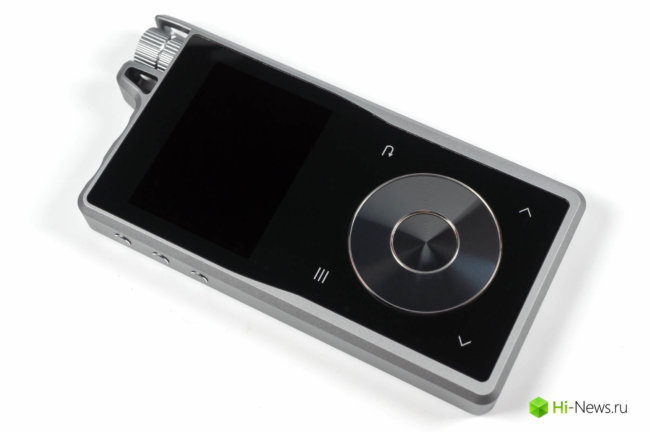
Firmware
If Soviet pilots instead of the heart was a flaming engine, QP2R it replaces Linux and the developers website proudly bears the logo of RedHat (though I doubt I used it). The same mind that gave steel hands, er… wings, made known to all Hiby.
Stitching on one side came out fairly traditional, with another — it has some nice features.
Traditionally, after running the player on the screen there is a menu of 5 items.
Playing — returns you to the playback screen, where everything traditionally shown the cover, with the wheel you can enable the display of text (if there are tags) and extended track information. Button submenu allows you to add a track to favorites, playlist, remove, or toggle the playback order.
Category — media library, there is also no surprises, you can see all the tracks in one list, artists, albums, genres, or display a list of records in DSD.
Playlists — simple and austere, a list of your playlists.
Browse Files — view the tracks by folder. Here, too, runs the pop-up menu, is necessary mainly for removal of tracks/folders.
Settings — settings. The first thing that draws attention here is the ability to hide some items. In Questyle rightly decided that flipping a long list of uncomfortable, so you can choose those items that you don’t need and remove them from sight. The approach is sound, for example, why often switch the interface language or the font size?
In General, the settings here a lot:
- Language (there are Russian)
- The font size
- Wallpaper of the main screen (option 4 + random selection)
- Gain (3 levels)
- BIAS (standard and enhanced)
- Additional reinforcement for DSD (from 0 to 6 dB)
- The equalizer (implemented well, but its inclusion still, the impact on sound quality)
- Channel balance
- The volume level of the line out in the dock (adjustable or maximum)
- The output mode of this dock (analog or digital)
- USB mode (memory or DAC)
- Sleep timer
- Library update
- The order of play
- Gapless playback
- Memorizing the position and volume when off
- The direction of rotation of the volume control
- Does this control when the screen is locked
- The brightness and working time of the backlight
- If it works when the screen is locked the lower button on the front panel
- Enable scrolling of the whole screen in the music list using the bottom buttons (the menu item “Flip Function”)
- The sensitivity of the touch-sensitive buttons and force vibration feedback
- Standard memory is formatted, factory reset, firmware update and information about the player.
“Soft” player is actively developing in the last two weeks that he was in my arms, was released two update that added a number of useful chips, so I want to believe that Questyle in the future will not forget to please us with new clothes. However, the firmware is already quite stable and almost devoid of “missing opportunities”, so probably updates will not be necessary.
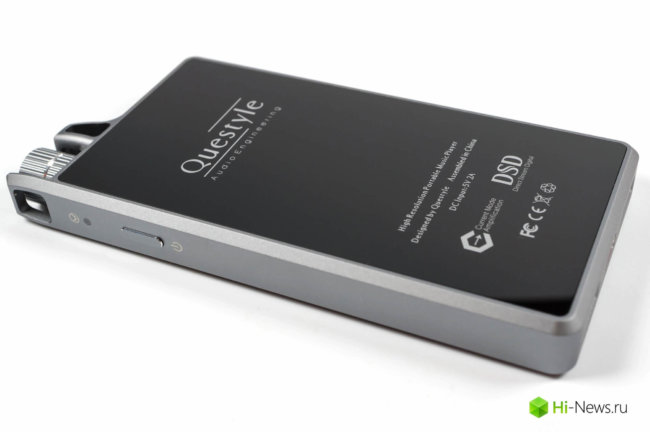
Sound
To listen to the device used the following headphones: iBasso IT03, 99 Meze Classics, Audio Zenith PMx2, Noble Kaiser Encore, Campfire Audio Andromeda, 64 Audio U12, HUM Pristine and others.
To my ears, QP1R was interesting player, with a pronounced “academic” sounding, sometimes he was even too technical, not all records are going to benefit. In the second generation, the developers have tried, on the one hand, to preserve this technicality, the other is to add the player a bit of what is sometimes called “musicality”, that is to make the flow a little more solid and a bit smoother, I guess they succeeded.
Low frequencies there is a little bit accentuated, of course, this is done not with the help of rise in frequency response player in this price category should be deprived of such vulgarity, the emphasis is using a bit of the underlined attacks and added weight. Such “additive” attaches to the supply QP2R a bit of warmth and what is sometimes called “musicality”, it sounds very nice, but not go to the detriment of resolution and detail. Player very good job with the textures and separation of instruments, low-frequency register, which adds the feed fraction of naturalness compared to the first generation. Lowest parts of the bass a little reserved on the second plan, which also benefits the natural wagering instruments and to General control flow. By the way, this accentuation of the bass a little more pronounced in the balanced output, so QP2R makes sense to look at the transition to the 2.5 mm connector.
The midrange has maintained the neutrality that was typical of the previous generation of players Questyle. QP2R not trying to embellish, to add emotion or to create something with an imaginary scene, he plays a whole “as is”, but does not fall down in the dry monitormost. On quality tracks it perfectly builds an imaginary scene, it is much more average in width and depth, with quality division of plans and tools, with bad records, the outcome could be much worse. However, to take a top player for a poorly recorded styles — originally a failed idea (although many people, for some reason it occurs).
Vernacularly range has also undergone minor processing, Questyle slightly reduced the aggressiveness of the flow, QP2R focuses not attack like its predecessor, overall I would characterize this as a “return to normal”. In terms of RF QP2R practically devoid of any distinct features, they are of good resolution, very good in attack and damping, perhaps they just do not have enough separation, typical of more expensive top players, but this is at the level of nuances, tracks on which you can hear very little.
Of course, can not do here without comparisons. I will limit myself to several top-end players, as comparison of “with everything” devoid of much sense.
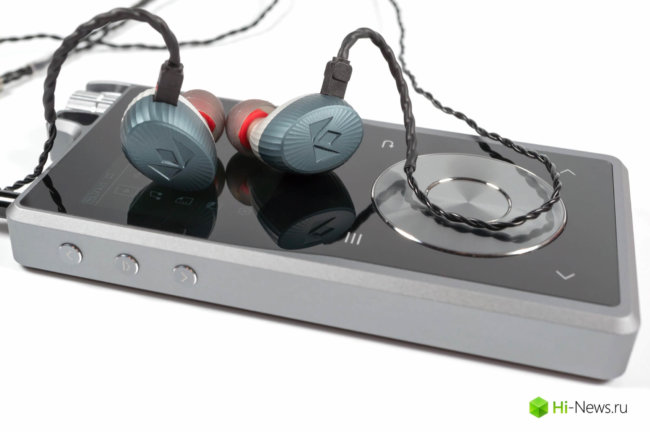
Astell&Kern AK320. Perhaps the best, in my opinion, a player from A&K, except for the new Ultima (I still haven’t listened to it yet but I plan to buy for my collection), offers a more “adult” sound — NCH even tighter, treble better defined, midrange is the signature “color,” which adds drama flow “astella”. QP2R, in turn, offers a slightly more neutral midrange, for those who want maximum neutrality and a bit more work.
Lotoo Paw Gold. Of course, LPG costs about 2 times more expensive, but once compared with the tops, then compare. “Gold” sounds more energetic, better conveys emotions and micronance tools, he is more focused and resilient in the bass, has much more reserve power and a little more aggressive passes the high-frequency range, however, the key word here “slightly”.
TheBit OPUS#2. Another good model for fans of “music” feed. Opus offers a more cohesive midrange, slightly more solid bass and less pronounced treble, while the Questyle have a little better midrange resolution and study the plans in depth.
iBasso DX200. If we talk about “bass” with the stock amp, it sounds more technical, and more neutral monitorna, but more demanding of the records. If you upgrade it to the AMP3, you will get a more natural (relative to QP2R) flow and better control tools to tight headphones, primarily due to the greater power of the amplifier.
Compatibility
QP2R not differ too much power, while the amplifier is operating in class A, easily cope with most earphones, except for very tight patterns. Have QP2R there is a small background noise with sensitive IEM, although you hear him mostly only in the pauses. In General, strong preference for headphones of this model is that you can choose, based on their tastes, but personally I’d prefer something neutral, with no pronounced coloring.
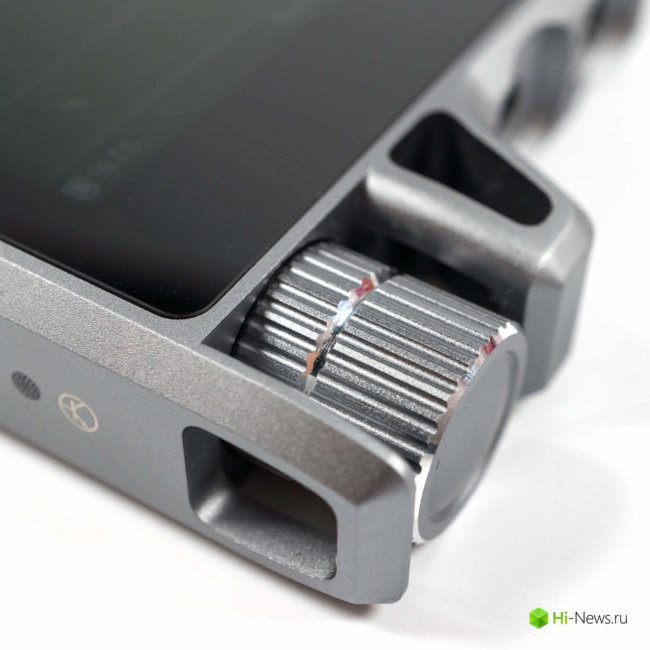
Genre player tends to be a “noble” styles like chamber music, vocal, jazz, classics, with them, his character is revealed in full, but with the other styles he shows himself more than worthy. Sensitivity to the quality of the recording is reasonable, somewhere in the 7 out of 10, the second generation due to a more musical flow behaves more tolerant of the first.
Traditionally, a few tracks-examples
Sepultura — Ratamahatta. If you did not know, then Sepultura came out very good remaster of their greatest album Roots. Unmatched lot of rage spewed Brazilians on this album, successfully fused with technical, but slightly obscured by the filing of a player, causing at least patting your foot to the beat.
Melody Gardot — Lisboa. Some wonderful jazz vocals adorn any collection, without exception, and if it’s Melody Gardot, I probably even have nothing to add, except that this track is also great to slightly tinted skilful manner QP2R. While lying, I also want to say that this album “The Absence” is Tidal in MQA.
Fleetwood Mac — The Chain. Well, since we are talking about the newfangled MQA in the context of the Tidal, here is another classic work is available in this format. Again, I don’t think Fleetwood Mac with its most popular album in need of some additional adjectives on my part. Great shock, easy lace-guitars, vocals — all QP2R delivers to maximum effect.
Insights
Questyle company that has all their: design, circuit design, vision sound. And the first and second generation of their players was not like the competitors, which is probably a huge advantage in our time the same devices. With QP2R, the company showed that they are able to vary their vision of sound, staying true to the “General trend”. If they made “killer of all”? Perhaps, to say so is an exaggeration. If they made it to make an interesting player that offers a funny, but interesting sound? Definitely, Yes.

A review of the Questyle QP2r player — in the spirit of fashion trends
Pavel Dmitriev